A Deep Learning Method for Ship Detection and Traffic Monitoring in an Offshore Wind Farm Area
Abstract
1. Introduction
- (1)
- This paper evaluates the performance of using the YOLOv7 model in offshore wind farm waters. It shows that the YOLOv7 model has a high accuracy rate for vessel detection. The results prove that the YOLOv7 models have higher dynamicity for ship detection compared to other ship detection methods.
- (2)
- An optimization strategy for training a visual-based identification model is presented. The study collects hybrid data sources (e.g., AIS data, images) to develop the model training database and validate the model by comparing the positions between AIS data and the detection results. consequently, this ensures the performance of continuous target detection with significant accuracy.
- (3)
- The proposed target identification system was further tested in an offshore case. By using an embedded device, the inference time reached real-time performance (less than 0.1 s) and the overall processing time for one frame was 0.76 s, proving the possibility of implementation of the system in real-time ship traffic monitoring.
2. Literature Review
2.1. Ship Monitoring Technology
2.2. Applications of Machine Vision in Target Detections
2.3. Applications of Machine Vision in Target Position and Tracking
3. Methods
4. Case Study
4.1. Database and Processing
4.2. Parameter Setting
4.3. Construction of the Training Database
4.4. Detection
4.5. Position and Tracking Results
5. Validation
5.1. Detection Validation
- ■
- Precision (P): proportion of samples that are correctly detected in all test results.
- ■
- Recall rate (R): proportion of actual positive samples that are correctly detected.
- ■
- False alarm rate (F): proportion of negative samples that are incorrectly detected as positive samples.
- ■
- Miss alarm rate (M): proportion of actual positive samples that are incorrectly detected as negative samples.
- ■
- Average precision (AP): the integral value of the Precision Rate-Recall rate curve (P-R curve).
- ■
- Average precision50 (AP50): the average accuracy of the test when the IOU threshold is 0.5.
- ■
- Average precision50:95 (AP50:95): the average accuracy of the test when the IOU threshold is 0.5–0.95.
5.2. Validating the Proposed Models
6. Discussion
6.1. Comparing the Current System Used for Ship Detection and Tracking
- (1)
- The proposed approach provides a way for ship monitoring with satisfactory accuracy and reliability. The developed system can obtain necessary information about ship traffic (e.g., speed, position, course), so that it becomes a novel supplement for VTS and OWF managers. In addition, in contrast to AIS and radar, this system uses cameras to collect ship videos, and the CCTVs are already fixed in most of the OWFs worldwide. Therefore, the cost of developing this system in practice can be very low.
- (2)
- As already mentioned, the proposed system has a high frequency of updating the ship information (i.e., 10 fps) and high accuracy in individual ship tracking (the tracking errors less than 15 m/0.0001 degrees). Thus, the developed system reasonably provides ship dynamic data and ensures collision risk assessment for ships in the vicinity of OWFs.
- (3)
- The proposed framework hybridizes several visual technologies. The study not only proves the possibility of using these technologies to aid ship monitoring in offshore wind farm waters but also can be considered as evidence to apply the machine visual model for ship detection and tracking in other similar waters, such as narrow channels, bridges, on a river, etc.
6.2. YOLO Series
7. Conclusions
Author Contributions
Funding
Institutional Review Board Statement
Informed Consent Statement
Data Availability Statement
Conflicts of Interest
Correction Statement
| 1 | 1000 images of inland ships were captured at Bay Park, Xiamen Bridge, and Gao Qi Wharf in Xiamen City, Fujian Province. |
References
- Vieira, M.; Henriques, E.; Snyder, B.; Reis, L. Insights on the impact of structural health monitoring systems on the operation and maintenance of offshore wind support structures. Struct. Saf. 2022, 94, 102154. [Google Scholar] [CrossRef]
- Musial, W.; Spitsen, P.; Duffy, P.; Beiter, P.; Marquis, M.; Hammond, R.; Shields, M. Offshore Wind Market Report: 2022 Edition; National Renewable Energy Lab. (NREL): Golden, CO, USA, 2022. [Google Scholar]
- Torres-Rincón, S.; Bastidas-Arteaga, E.; Sánchez-Silva, M. A flexibility-based approach for the design and management of floating offshore wind farms. Renew. Energy 2021, 175, 910–925. [Google Scholar] [CrossRef]
- Brady, R.L. Offshore Wind Industry Interorganizational Collaboration Strategies in Emergency Management; Walden University: Minneapolis, MN, USA, 2022. [Google Scholar]
- Li, B.; Xie, X.; Wei, X.; Tang, W. Ship detection and classification from optical remote sensing images: A survey. Chin. J. Aeronaut. 2021, 34, 145–163. [Google Scholar] [CrossRef]
- Zhao, J.; Guo, W.; Zhang, Z.; Yu, W. A coupled convolutional neural network for small and densely clustered ship detection in SAR images. Sci. China Inf. Sci. 2018, 62, 42301. [Google Scholar] [CrossRef]
- Zhang, S.; Wu, R.; Xu, K.; Wang, J.; Sun, W. R-CNN-Based Ship Detection from High Resolution Remote Sensing Imagery. Remote Sens. 2019, 11, 631. [Google Scholar] [CrossRef]
- Hu, J.; Zhi, X.; Shi, T.; Yu, L.; Zhang, W. Ship Detection via Dilated Rate Search and Attention-Guided Feature Representation. Remote Sens. 2021, 13, 4840. [Google Scholar] [CrossRef]
- Yu, C.; Shin, Y. SAR ship detection based on improved YOLOv5 and BiFPN. ICT Express 2023. [Google Scholar] [CrossRef]
- Priakanth, P.; Thangamani, M.; Ganthimathi, M. WITHDRAWN: Design and Development of IOT Based Maritime Monitoring Scheme for Fishermen in India; Elsevier: Amsterdam, The Netherlands, 2021. [Google Scholar]
- Ouelmokhtar, H.; Benmoussa, Y.; Benazzouz, D.; Ait-Chikh, M.A.; Lemarchand, L. Energy-based USV maritime monitoring using multi-objective evolutionary algorithms. Ocean Eng. 2022, 253, 111182. [Google Scholar] [CrossRef]
- Nyman, E. Techno-optimism and ocean governance: New trends in maritime monitoring. Mar. Policy 2019, 99, 30–33. [Google Scholar] [CrossRef]
- Pawar, K.; Attar, V. Deep learning based detection and localization of road accidents from traffic surveillance videos. ICT Express 2022, 8, 379–387. [Google Scholar] [CrossRef]
- Thallinger, G.; Krebs, F.; Kolla, E.; Vertal, P.; Kasanický, G.; Neuschmied, H.; Ambrosch, K.-E. Near-miss accidents–classification and automatic detection. In Proceedings of the Intelligent Transport Systems—From Research and Development to the Market Uptake: First International Conference, INTSYS 2017, Hyvinkää, Finland, 29–30 November 2017; Proceedings 1. pp. 144–152. [Google Scholar]
- Pramanik, A.; Sarkar, S.; Maiti, J. A real-time video surveillance system for traffic pre-events detection. Accid. Anal. Prev. 2021, 154, 106019. [Google Scholar] [CrossRef] [PubMed]
- Root, B. HF radar ship detection through clutter cancellation. In Proceedings of the 1998 IEEE Radar Conference, RADARCON’98, Challenges in Radar Systems and Solutions, Dallas, TX, USA, 14 May 1998; pp. 281–286. [Google Scholar]
- Dzvonkovskaya, A.; Gurgel, K.-W.; Rohling, H.; Schlick, T. Low power high frequency surface wave radar application for ship detection and tracking. In Proceedings of the 2008 International Conference on Radar, Adelaide, SA, Australia, 2–5 September 2008; pp. 627–632. [Google Scholar]
- Margarit, G.; Barba Milanés, J.; Tabasco, A. Operational Ship Monitoring System Based on Synthetic Aperture Radar Processing. Remote Sens. 2009, 1, 375–392. [Google Scholar] [CrossRef]
- Brekke, C. Automatic Ship Detection Based on Satellite SAR; FFI-rapport: Kjeller, Norway, 2008. [Google Scholar]
- Kazimierski, W.; Stateczny, A. Fusion of Data from AIS and Tracking Radar for the Needs of ECDIS. In Proceedings of the 2013 Signal Processing Symposium (SPS), Serock, Poland, 5–7 June 2013; pp. 1–6. [Google Scholar]
- Pan, Z.; Deng, S. Vessel Real-Time Monitoring System Based on AIS Temporal Database. In Proceedings of the 2009 International Conference on Information Management, Innovation Management and Industrial Engineering, Kuala Lumpur, Malaysia, 3–5 April 2009; pp. 611–614. [Google Scholar]
- Lin, B.; Huang, C.-H. Comparison between Arpa Radar and Ais Characteristics for Vessel Traffic Services. J. Mar. Sci. Technol. 2006, 14, 7. [Google Scholar] [CrossRef]
- Yu, Q.; Liu, K.; Chang, C.-H.; Yang, Z. Realising advanced risk assessment of vessel traffic flows near offshore wind farms. Reliab. Eng. Syst. Saf. 2020, 203, 107086. [Google Scholar] [CrossRef]
- Chang, C.-H.; Kontovas, C.; Yu, Q.; Yang, Z. Risk assessment of the operations of maritime autonomous surface ships. Reliab. Eng. Syst. Saf. 2021, 207, 107324. [Google Scholar] [CrossRef]
- Yu, Q.; Liu, K.; Teixeira, A.; Soares, C.G. Assessment of the influence of offshore wind farms on ship traffic flow based on AIS data. J. Navig. 2020, 73, 131–148. [Google Scholar] [CrossRef]
- Liu, Y.; Su, H.; Zeng, C.; Li, X. A Robust Thermal Infrared Vehicle and Pedestrian Detection Method in Complex Scenes. Sensor 2021, 21, 1240. [Google Scholar] [CrossRef] [PubMed]
- Shao, Z.; Wang, L.; Wang, Z.; Du, W.; Wu, W. Saliency-aware convolution neural network for ship detection in surveillance video. IEEE Trans. Circuits Syst. Video Technol. 2019, 30, 781–794. [Google Scholar] [CrossRef]
- Chen, Z.; Li, B.; Tian, L.F.; Chao, D. Automatic detection and tracking of ship based on mean shift in corrected video sequences. In Proceedings of the 2017 2nd International Conference on Image, Vision and Computing (ICIVC), Chengdu, China, 2–4 June 2017; pp. 449–453. [Google Scholar]
- Rahmatov, N.; Paul, A.; Saeed, F.; Hong, W.-H.; Seo, H.; Kim, J. Machine learning–based automated image processing for quality management in industrial Internet of Things. Int. J. Distrib. Sens. Netw. 2019, 15, 1550147719883551. [Google Scholar] [CrossRef]
- Chávez Heras, D.; Blanke, T. On machine vision and photographic imagination. AI Soc. 2020, 36, 1153–1165. [Google Scholar] [CrossRef]
- Cho, S.; Kwon, J. Abnormal event detection by variation matching. Mach. Vis. Appl. 2021, 32, 80. [Google Scholar] [CrossRef]
- Lowe, D.G. Object recognition from local scale-invariant features. In Proceedings of the Seventh IEEE International Conference on Computer Vision, Kerkyra, Greece, 20–27 September 1999; pp. 1150–1157. [Google Scholar]
- Orr, G.B.; Müller, K.-R. Neural Networks: Tricks of the Trade; Springer: Berlin/Heidelberg, Germany, 1998. [Google Scholar]
- Qi, S.; Ma, J.; Lin, J.; Li, Y.; Tian, J. Unsupervised ship detection based on saliency and S-HOG descriptor from optical satellite images. IEEE Geosci. Remote Sens. Lett. 2015, 12, 1451–1455. [Google Scholar]
- Zhu, C.; He, Y.; Savvides, M. Feature selective anchor-free module for single-shot object detection. In Proceedings of the IEEE/CVF Conference on Computer Vision and Pattern Recognition, Long Beach, CA, USA, 15–20 June 2019; pp. 840–849. [Google Scholar]
- Law, H.; Deng, J. CornerNet: Detecting objects as paired keypoints. In Proceedings of the European conference on computer vision (ECCV), Munich, Germany, 8–14 September 2018; pp. 734–750. [Google Scholar]
- Bochkovskiy, A.; Wang, C.-Y.; Liao, H.-Y.M. Yolov4: Optimal speed and accuracy of object detection. arXiv 2020, arXiv:2004.10934. [Google Scholar]
- Chen, Z.; Liu, C.; Filaretov, V.F.; Yukhimets, D.A. Multi-Scale Ship Detection Algorithm Based on YOLOv7 for Complex Scene SAR Images. Remote Sens. 2023, 15, 2071. [Google Scholar] [CrossRef]
- Cen, J.; Feng, H.; Liu, X.; Hu, Y.; Li, H.; Li, H.; Huang, W. An Improved Ship Classification Method Based on YOLOv7 Model with Attention Mechanism. Wirel. Commun. Mob. Comput. 2023, 2023, 7196323. [Google Scholar] [CrossRef]
- Yasir, M.; Zhan, L.; Liu, S.; Wan, J.; Hossain, M.S.; Isiacik Colak, A.T.; Liu, M.; Islam, Q.U.; Raza Mehdi, S.; Yang, Q. Instance segmentation ship detection based on improved Yolov7 using complex background SAR images. Front. Mar. Sci. 2023, 10. [Google Scholar] [CrossRef]
- Liu, W.; Anguelov, D.; Erhan, D.; Szegedy, C.; Reed, S.; Fu, C.-Y.; Berg, A.C. Ssd: Single shot multibox detector. In Proceedings of the Computer Vision–ECCV 2016: 14th European Conference, Amsterdam, The Netherlands, 11–14 October 2016; Proceedings, Part I 14. pp. 21–37. [Google Scholar]
- Girshick, R.; Donahue, J.; Darrell, T.; Malik, J. Rich feature hierarchies for accurate object detection and semantic segmentation. In Proceedings of the IEEE Conference on Computer Vision and Pattern Recognition, Portland, OR, USA, 23–28 June 2013; pp. 580–587. [Google Scholar]
- Meng, C.; Bao, H.; Ma, Y.; Xu, X.; Li, Y. Visual Meterstick: Preceding Vehicle Ranging Using Monocular Vision Based on the Fitting Method. Symmetry 2019, 11, 1081. [Google Scholar] [CrossRef]
- Zhao, Y.; Zhao, L.; Xiong, B.; Kuang, G. Attention receptive pyramid network for ship detection in SAR images. IEEE J. Sel. Top. Appl. Earth Obs. Remote Sens. 2020, 13, 2738–2756. [Google Scholar] [CrossRef]
- Redmon, J.; Divvala, S.; Girshick, R.; Farhadi, A. You only look once: Unified, real-time object detection. In Proceedings of the IEEE Conference on Computer Vision and Pattern Recognition, Boston, MA, USA, 7–12 June 2015; pp. 779–788. [Google Scholar]
- Gong, H.; Li, H.; Xu, K.; Zhang, Y. Object detection based on improved YOLOv3-tiny. In Proceedings of the 2019 Chinese automation congress (CAC), Hangzhou, China, 22–24 November 2019; pp. 3240–3245. [Google Scholar]
- Patel, K.; Bhatt, C.; Mazzeo, P.L. Improved Ship Detection Algorithm from Satellite Images Using YOLOv7 and Graph Neural Network. Algorithms 2022, 15, 473. [Google Scholar] [CrossRef]
- Li, J.; Qu, C.; Shao, J. Ship detection in SAR images based on an improved faster R-CNN. In Proceedings of the 2017 SAR in Big Data Era: Models, Methods and Applications (BIGSARDATA), Beijing, China, 13–14 November 2017; pp. 1–6. [Google Scholar]
- Li, Y.; Rong, L.; Li, R.; Xu, Y. Fire Object Detection Algorithm Based on Improved YOLOv3-tiny. In Proceedings of the 2022 7th International Conference on Cloud Computing and Big Data Analytics (ICCCBDA), Chengdu, China, 22–24 April 2022; pp. 264–269. [Google Scholar]
- Ren, S.; He, K.; Girshick, R.; Sun, J. Faster r-cnn: Towards real-time object detection with region proposal networks. Adv. Neural Inf. Process. Syst. 2015, 28, 1137–1149. [Google Scholar] [CrossRef]
- Campbell, J.; Sukthankar, R.; Nourbakhsh, I.; Pahwa, A. A robust visual odometry and precipice detection system using consumer-grade monocular vision. In Proceedings of the 2005 IEEE International Conference on Robotics and Automation, Barcelona, Spain, 18–22 April 2005; pp. 3421–3427. [Google Scholar]
- Matthies, L.; Shafer, S. Error modeling in stereo navigation. IEEE J. Robot. Autom. 1987, 3, 239–248. [Google Scholar] [CrossRef]
- Davison, A.J. Real-time simultaneous localisation and mapping with a single camera. In Proceedings of the Computer Vision, IEEE International Conference, Nice, France, 13–16 October 2003; p. 1403. [Google Scholar]
- Schwartzkroin, P.A. Neural Mechanisms: Synaptic Plasticity. Molecular, Cellular, and Functional Aspects. Michel Baudry, Richard F. Thompson, and Joel L. Davis, Eds. MIT Press, Cambridge, MA, 1993. xiv, 263 pp., illus. $50 or£ 44.95. Science 1994, 264, 1179–1180. [Google Scholar] [CrossRef] [PubMed]
- Howard, I.P.; Rogers, B.J. Binocular Vision and Stereopsis; Oxford University Press: Oxford, UK, 1995. [Google Scholar]
- Xu, Y.; Zhao, Y.; Wu, F.; Yang, K. Error analysis of calibration parameters estimation for binocular stereo vision system. In Proceedings of the 2013 IEEE International Conference on Imaging Systems and Techniques (IST), Beijing, China, 22–23 October 2013; pp. 317–320. [Google Scholar]
- Yu, Y.; Tingting, W.; Long, C.; Weiwei, Z. Stereo vision based obstacle avoidance strategy for quadcopter UAV. In Proceedings of the 2018 Chinese Control And Decision Conference (CCDC), Shenyang, China, 9–11 June 2018; pp. 490–494. [Google Scholar]
- Sun, X.; Jiang, Y.; Ji, Y.; Fu, W.; Yan, S.; Chen, Q.; Yu, B.; Gan, X. Distance measurement system based on binocular stereo vision. In Proceedings of the IOP Conference Series: Earth and Environmental Science, Hainan, China, 25–26 April 2009; p. 052051. [Google Scholar]
- Wang, C.; Zou, X.; Tang, Y.; Luo, L.; Feng, W. Localisation of litchi in an unstructured environment using binocular stereo vision. Biosyst. Eng. 2016, 145, 39–51. [Google Scholar] [CrossRef]
- Zou, X.; Zou, H.; Lu, J. Virtual manipulator-based binocular stereo vision positioning system and errors modelling. Mach. Vis. Appl. 2012, 23, 43–63. [Google Scholar] [CrossRef]
- Zuo, X.; Xie, X.; Liu, Y.; Huang, G. Robust visual SLAM with point and line features. In Proceedings of the 2017 IEEE/RSJ International Conference on Intelligent Robots and Systems (IROS), Vancouver, BC, Canada, 24–28 September 2017; pp. 1775–1782. [Google Scholar]
- Hong, Z.; Yang, T.; Tong, X.; Zhang, Y.; Jiang, S.; Zhou, R.; Han, Y.; Wang, J.; Yang, S.; Liu, S. Multi-Scale Ship Detection From SAR and Optical Imagery Via A More Accurate YOLOv3. IEEE J. Sel. Top. Appl. Earth Obs. Remote Sens. 2021, 14, 6083–6101. [Google Scholar] [CrossRef]
- Cao, C.; Wu, J.; Zeng, X.; Feng, Z.; Wang, T.; Yan, X.; Wu, Z.; Wu, Q.; Huang, Z. Research on Airplane and Ship Detection of Aerial Remote Sensing Images Based on Convolutional Neural Network. Sensor 2020, 20, 4696. [Google Scholar] [CrossRef]
- Yang, R.; Wang, R.; Deng, Y.; Jia, X.; Zhang, H. Rethinking the Random Cropping Data Augmentation Method Used in the Training of CNN-Based SAR Image Ship Detector. Remote Sens. 2020, 13, 34. [Google Scholar] [CrossRef]

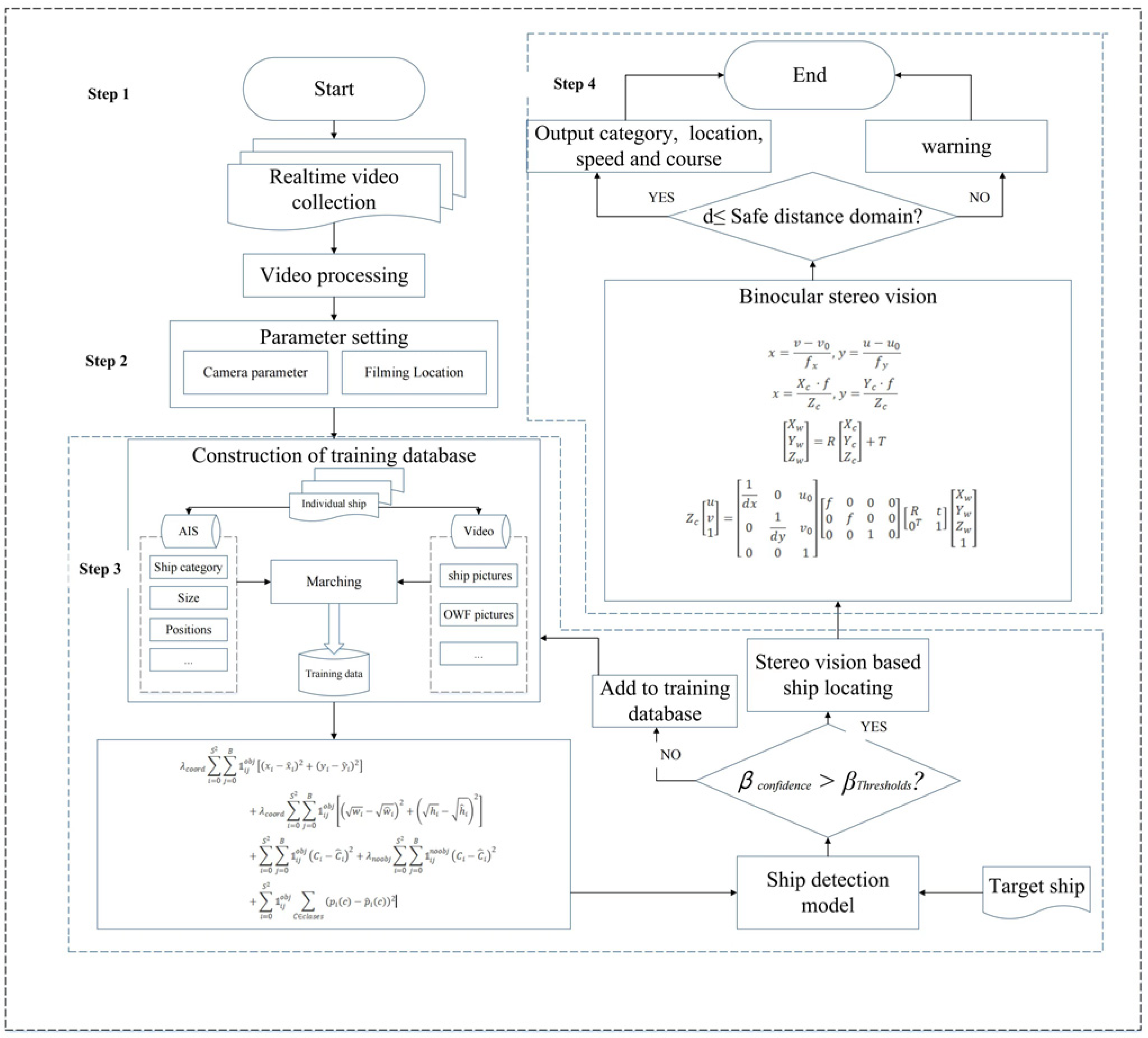

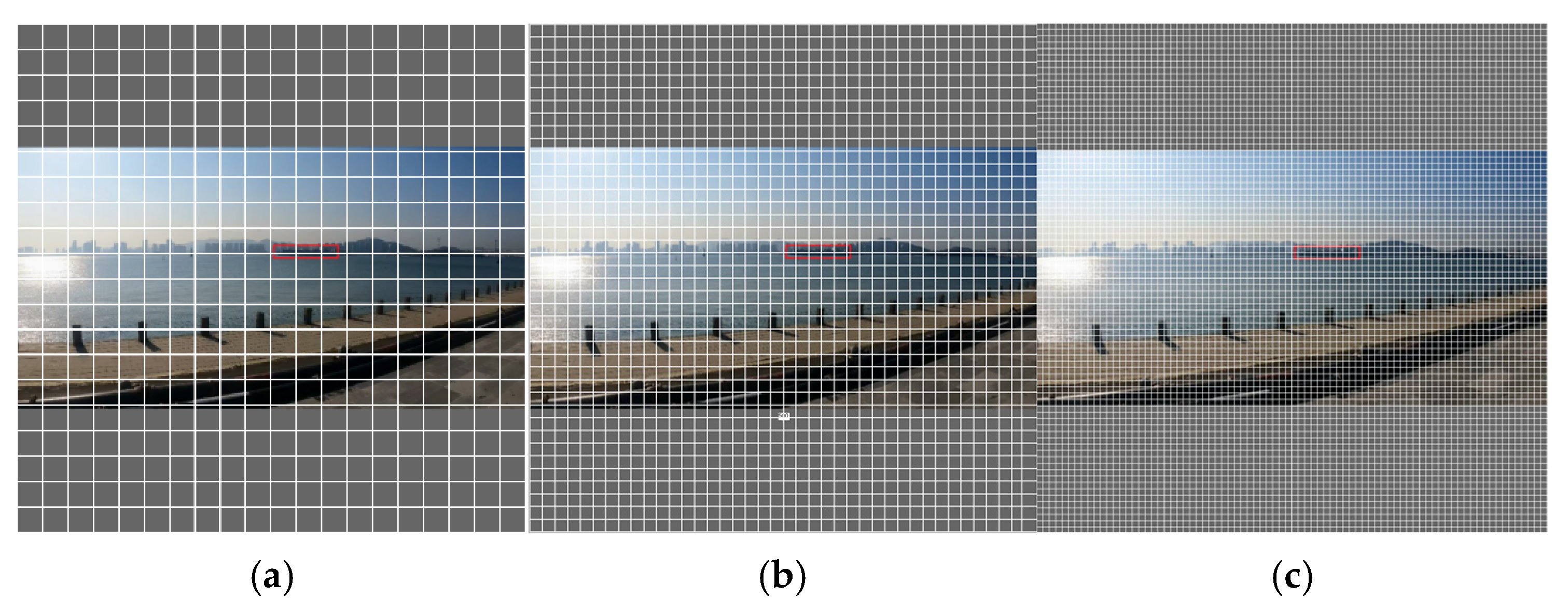
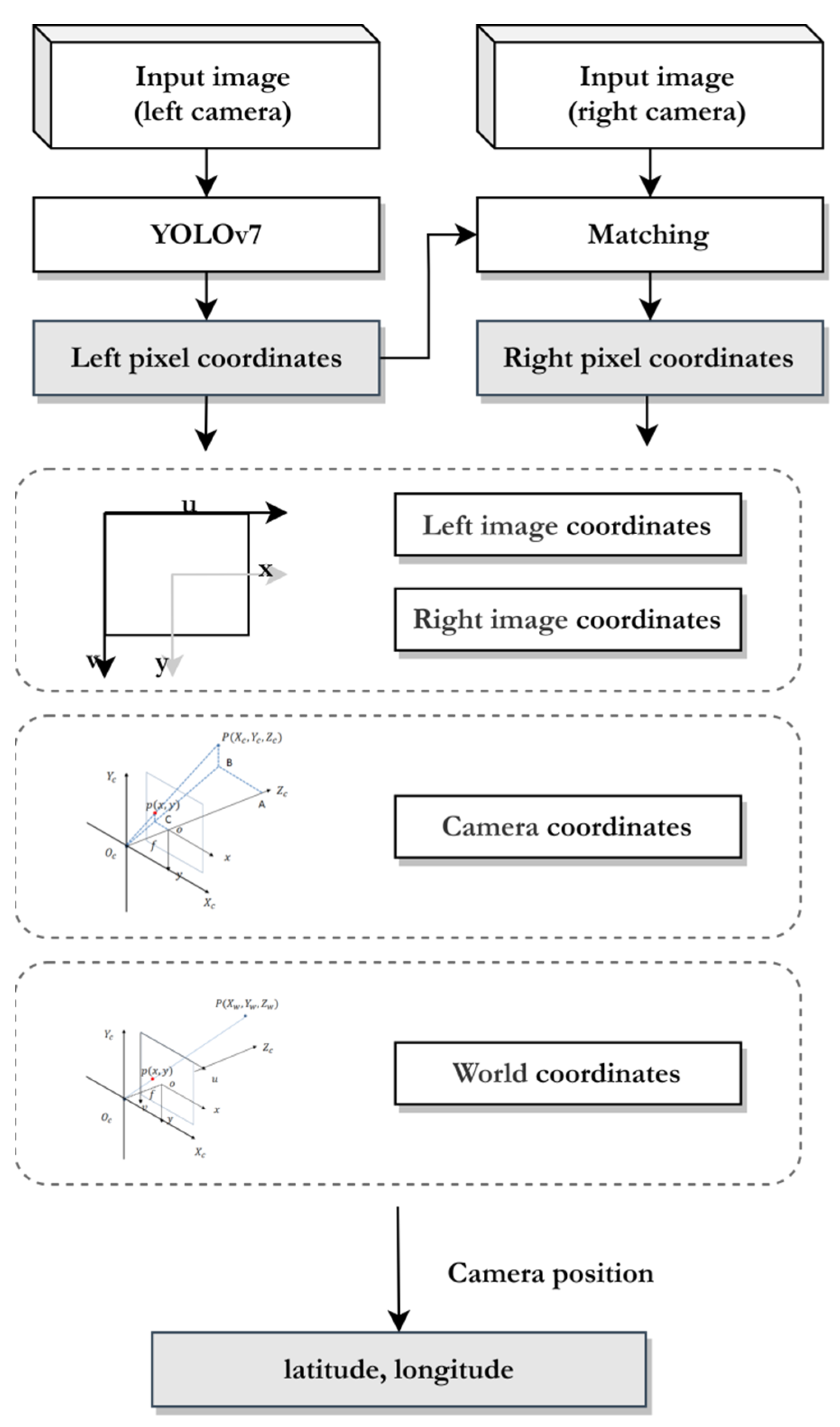
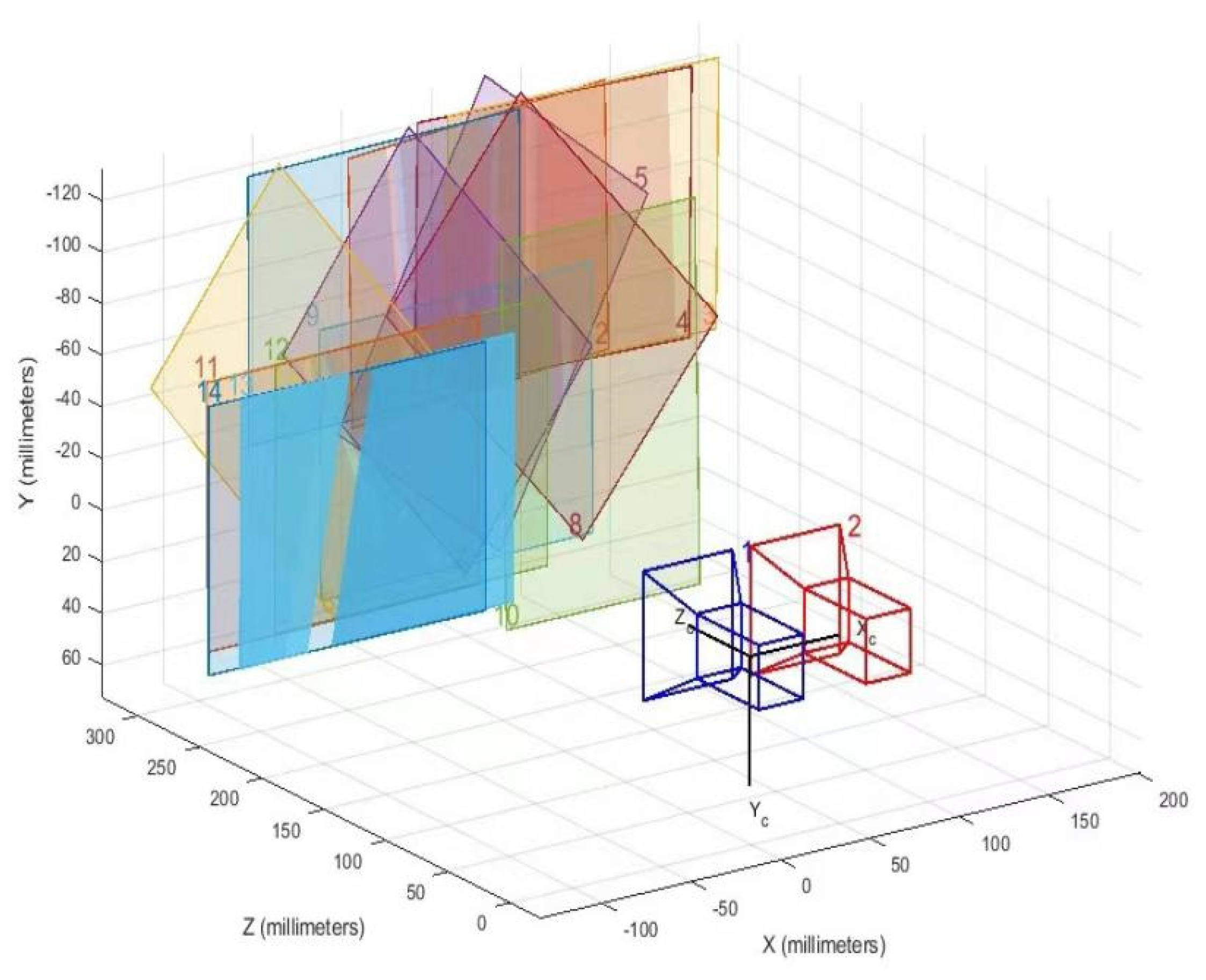
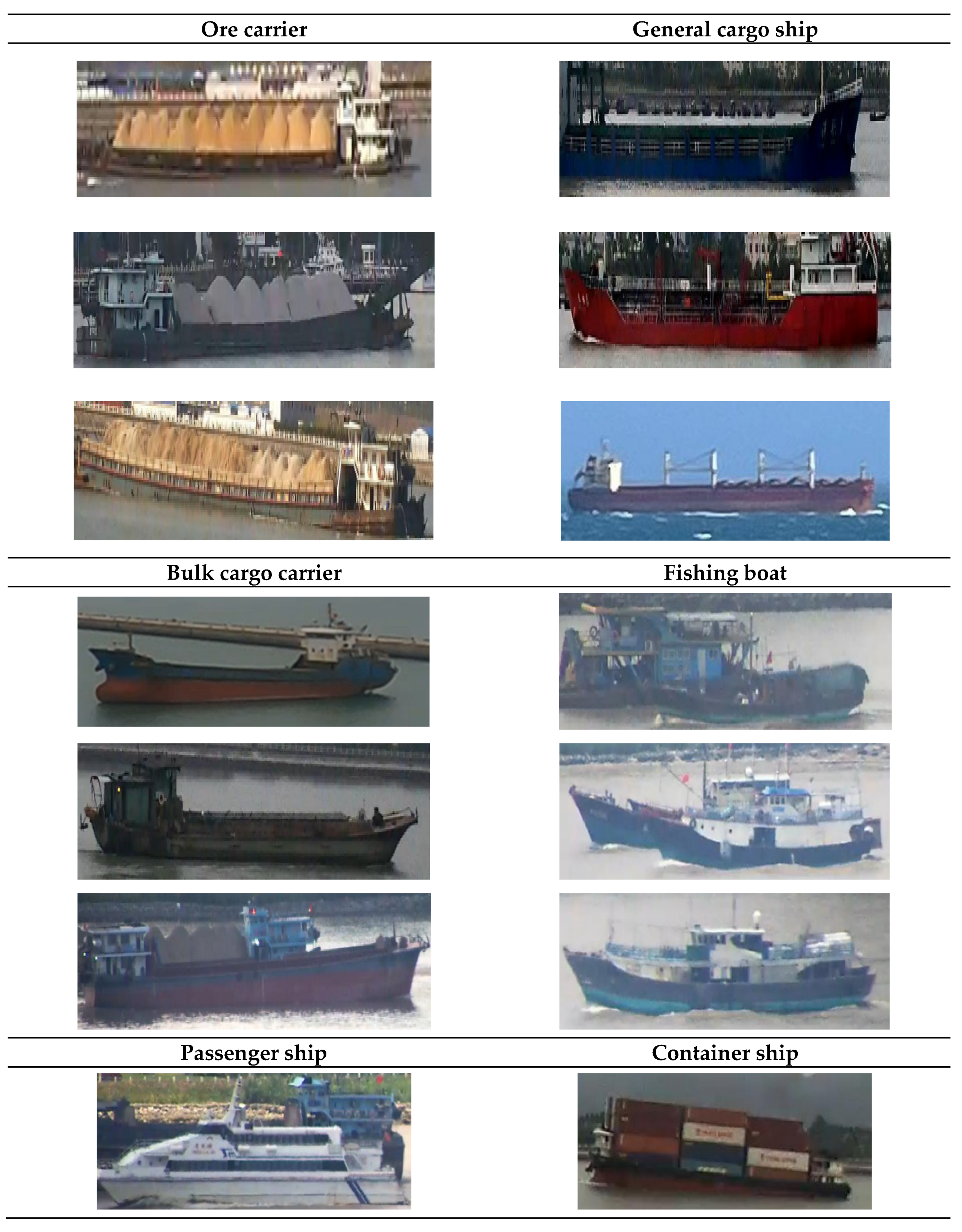
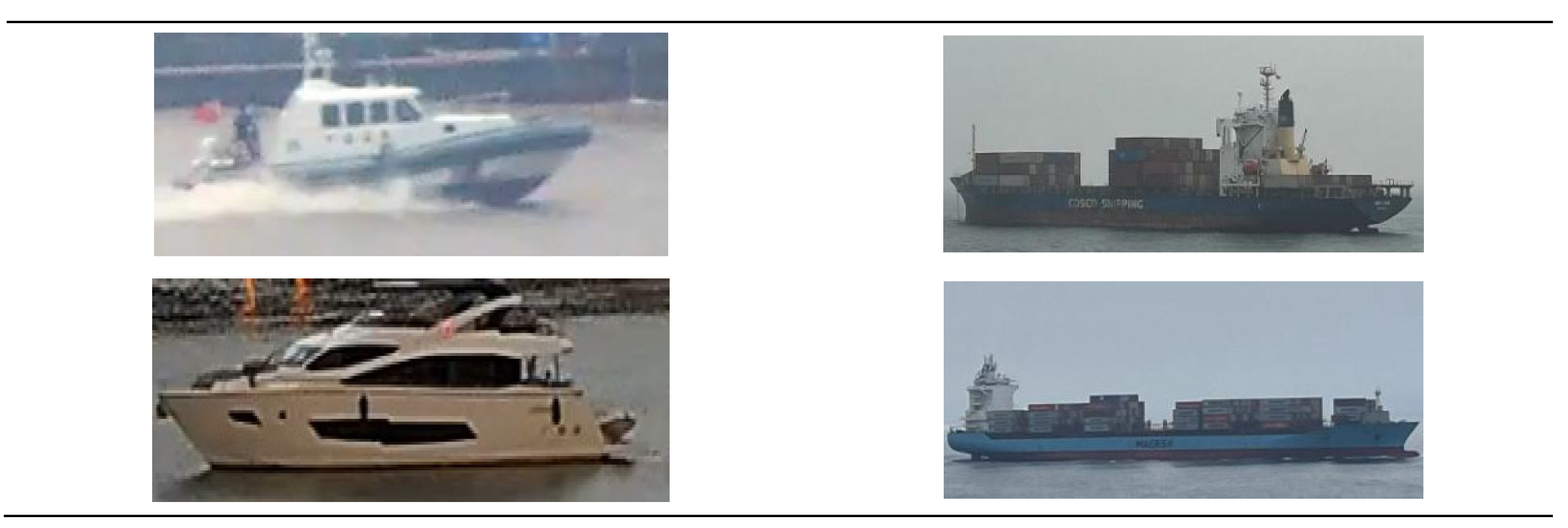

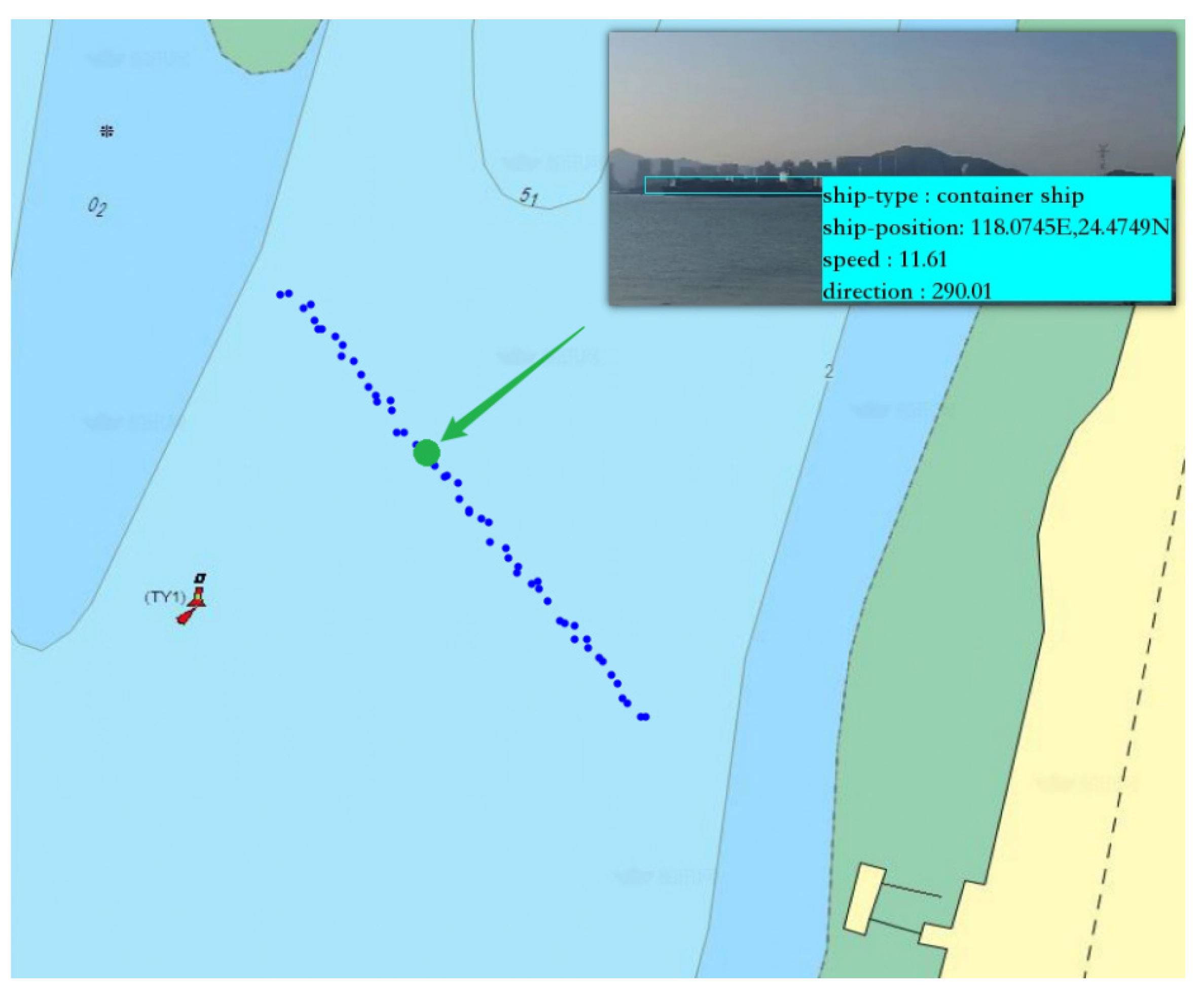
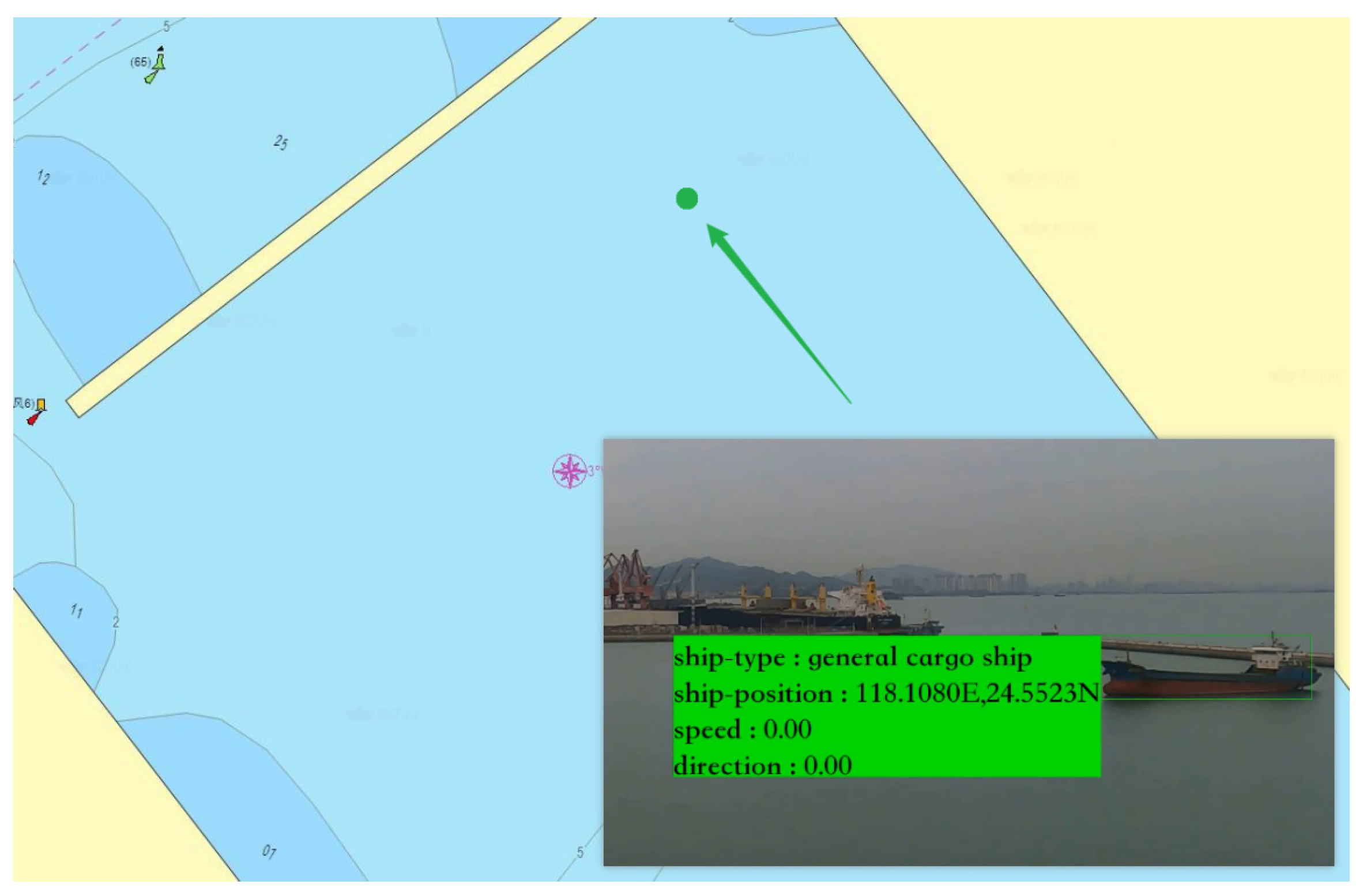
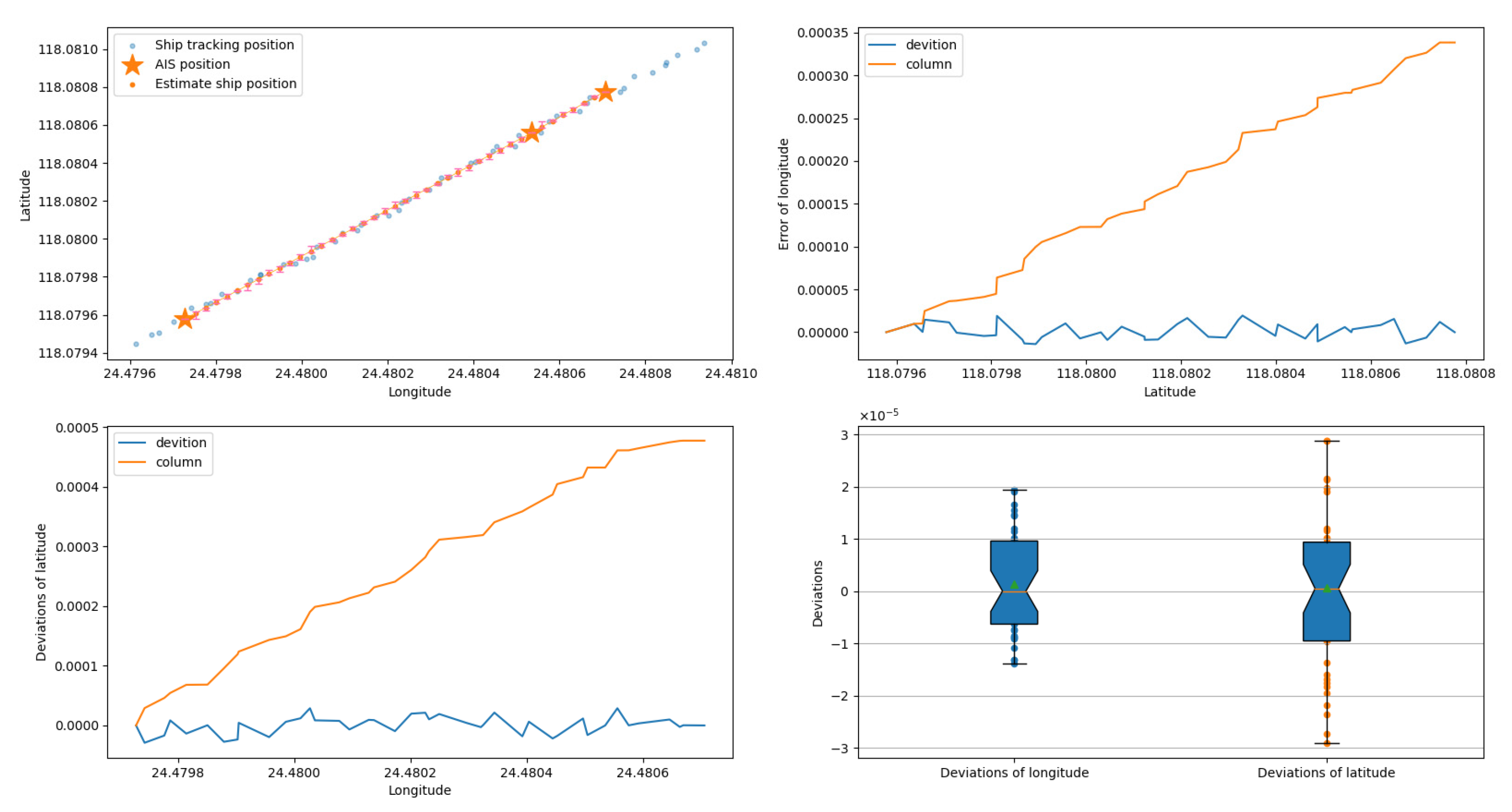
| Database | Number of Samples | Number of Ships | ||
|---|---|---|---|---|
| MYSHIP | SEASHIP | MYSHIP | SEASHIP | |
| Training set | 600 | 4200 | 1334 | 4934 |
| Validation set | 200 | 1400 | 444 | 1610 |
| Test set | 200 | 1400 | 446 | 1669 |
| Total | 1000 | 7000 | 2224 | 8213 |
| Parameter Name | Parameter | Unit |
|---|---|---|
| Focal length | 12.5–775 | mm |
| Pixel | 3 | mp |
| Resolution | 2048*1536 | ppi |
| Wide dynamic range | 120 | db |
| Setting | Intrinsic Matrix | Rotation | Translation | Distortion |
|---|---|---|---|---|
| Pixel | m | m | m | |
|
Left camera | ||||
|
Right camera |
| No. | Frame Rate (fps) | Resolution | Duration(s) | Category | Ship Status |
|---|---|---|---|---|---|
| video#1 | 10 | 720 × 1280 | 150 | Container ship | Underway |
| video#2 | 10 | 2160 × 3840 | 60 | Bulk cargo carrier | Moored |
| video#3 | 10 | 2160 × 3840 | 480 | Passenger ship | Moored |
| video#4 | 10 | 2160 × 3840 | 60 | Passenger ship Fishing boat | Underway Anchored |
| No. | Minimum Confidence | Maximum Confidence | Average Confidence |
|---|---|---|---|
| Video 1 | 0.95 | 1.00 | 0.97 |
| Video 2 | 0.99 | 1.00 | 0.99 |
| Video 3 | 0.50 | 0.94 | 0.76 |
| Video 4 | 0.53 | 0.84 | 0.72 |
| Database | P | R | F | M | AP50 | AP50:95 |
|---|---|---|---|---|---|---|
| MYSHIP | 74.38% | 78.20% | 21.80% | 25.62% | 97.10% | 72.61% |
| SEASHIP | 62.49% | 70.97% | 29.03% | 37.52% | 96.40% | 61.61% |
| Video #1 | Video #2 | Video #3 | Video #4 | |
|---|---|---|---|---|
| System result | Container ship | General cargo ship | Passenger ship × 5 General cargo ship × 2 | Fishing boat Passenger ship |
| AIS data | Container ship | General cargo ship | Passenger ship × 2 | Passenger ship |
| Sample#1 | Sample#2 | Sample#3 | Sample#4 | ||
|---|---|---|---|---|---|
| System output | Longitude | 118.0796 E | 118.1074 E | 118.1081 E | 118.1117 E |
| Latitude | 24.4806 N | 24.5521 N | 24.5466 N | 24.5579 N | |
| AIS data (°) | Longitude | 118.07962 E | 118.10737 E | 118.10814 E | 118.11169 E |
| Latitude | 24.48064 N | 24.55212 N | 24.54661 N | 24.55791 N | |
| Deviation (°) | Longitude | 0.00002 | −0.00003 | 0.00004 | −0.00001 |
| Latitude | 0.00004 | 0.00002 | 0.00001 | 0.00001 |
| Method Name | Advantage | Disadvantage |
|---|---|---|
| AIS based ship reporting system | 1. Capable of automatically obtaining target position, status, speed, and other information 2. High accuracy of ship dynamic data 3. Strong performance against rain, snow, and wave interference 4. Eliminate the blocking area of some radars | 1. Operates only at VHF 2. Cannot identify targets without AIS devices installed 3. The data are not continuous and poor timeliness |
| Radar tracking system | 1. Capable of automatic tracking and automatic warning 2. Accurate measurement and display of distance, bearing, speed and size of the target | 1. Blind spots exist 2. The echo is easily affected by weather, sea state and terrain obstruction, etc. 3. In the multi-target dense area is prone to false tracking and target loss phenomenon |
| YOLO model | 1. Has a high recognition speed, and can efficiently identify multiple targets 2. Superiority in real-time target detection 3. Suitable for detecting objects of various shapes and sizes | 1. Global information has a good performance, but poor performance on a small range of information 2. Compared to some recognition algorithms, the accuracy rate is slightly worse |
| RCNN model | 1. Powerful adaptability for recognition and classification of complex data 2. Feature classification works well | 1. Large number of operations, large sample size and time are required to train the model 2. Lack of annotation resources for specific target samples, high quality for the database |
| Methods | P | R | F | M | ||
|---|---|---|---|---|---|---|
| YOLOv5 | 73.80% | 73.41% | 26.20% | 26.60% | 95.76% | 70.37% |
| YOLOv7 | 77.48% | 73.19% | 22.52% | 26.81% | 97.03% | 71.51% |
Disclaimer/Publisher’s Note: The statements, opinions and data contained in all publications are solely those of the individual author(s) and contributor(s) and not of MDPI and/or the editor(s). MDPI and/or the editor(s) disclaim responsibility for any injury to people or property resulting from any ideas, methods, instructions or products referred to in the content. |
© 2023 by the authors. Licensee MDPI, Basel, Switzerland. This article is an open access article distributed under the terms and conditions of the Creative Commons Attribution (CC BY) license (https://creativecommons.org/licenses/by/4.0/).
Share and Cite
Liu, X.; Hu, Y.; Ji, H.; Zhang, M.; Yu, Q. A Deep Learning Method for Ship Detection and Traffic Monitoring in an Offshore Wind Farm Area. J. Mar. Sci. Eng. 2023, 11, 1259. https://doi.org/10.3390/jmse11071259
Liu X, Hu Y, Ji H, Zhang M, Yu Q. A Deep Learning Method for Ship Detection and Traffic Monitoring in an Offshore Wind Farm Area. Journal of Marine Science and Engineering. 2023; 11(7):1259. https://doi.org/10.3390/jmse11071259
Chicago/Turabian StyleLiu, Xintong, Yutian Hu, Huiting Ji, Mingyang Zhang, and Qing Yu. 2023. "A Deep Learning Method for Ship Detection and Traffic Monitoring in an Offshore Wind Farm Area" Journal of Marine Science and Engineering 11, no. 7: 1259. https://doi.org/10.3390/jmse11071259
APA StyleLiu, X., Hu, Y., Ji, H., Zhang, M., & Yu, Q. (2023). A Deep Learning Method for Ship Detection and Traffic Monitoring in an Offshore Wind Farm Area. Journal of Marine Science and Engineering, 11(7), 1259. https://doi.org/10.3390/jmse11071259







